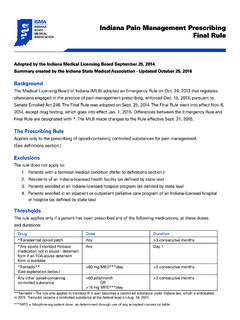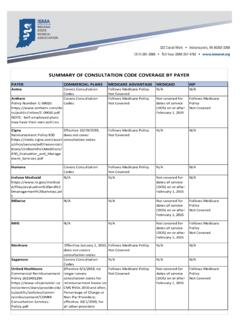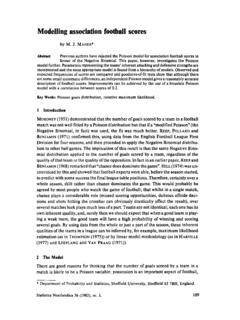Transcription of Indiana’s Medical Malpractice Act
1 KEY FEATURES OF indiana 'S Medical Malpractice ACT. What makes indiana 's Medical Malpractice Act different from laws in other states? indiana was the first state to pass Medical Malpractice reform legislation in 1975. Our law has repeatedly withstood constitutionality challenges, unlike laws in many other states that have been overturned. indiana 's act caps total damages available to a patient for an act of Malpractice at $ million. The cap has been raised twice since 1975. This cap helps keep insurance rates lower than rates in other states that do not have caps on damages (very few states do).
2 In turn, more physicians can afford to practice in indiana , and patients have access to the care they need. Physicians are only responsible for the first $250,000 in damages to any patient for one act of Malpractice and no more than $750,000 in the annual aggregate. The state Patient's Compensation Fund (PCF) pays any excess, not to exceed $1 million -- for a total of $ million. The PCF helps ensure a guaranteed source of compensation for injured patients, unlike other states where patients may not recover large verdicts because the provider does not have adequate insurance or assets.
3 Plaintiffs' attorneys are not entitled to receive more than 15 percent of any recovery from the Patient's Compensation Fund. The act does not limit their fees from the first $250,000, but case law and ethical rules require that it be reasonable. What kind of insurance do you need? Physicians are not required by indiana law to maintain any Malpractice insurance. However, as a practical matter, employers, hospitals and payers usually require it. Additionally, in order to qualify for the protections built into indiana 's law, like capped liability, physicians must purchase commercial insurance to cover their first $250,000 in liability for each patient and pay a surcharge to the Patient's Compensation Fund to cover the next $1 million in potential liability.
4 The surcharge amount varies by specialty. How long do patients have to sue? Patients must file Malpractice claims within two (2) years from the alleged act of Malpractice . However, minors under the age of six (6) have until their eighth birthday to file. In very limited circumstances, courts may allow patients to file their claim after these time limits have expired if the patient could not have reasonably discovered the Malpractice within that time. Can patients automatically sue in court? No. Patients first must file a proposed complaint with the indiana Department of Insurance and have their case evaluated by a Medical review panel consisting of three physicians.
5 If there is only one defendant, at least two of the three panelists must be from the defendant's specialty. If there are multiple defendants, the parties try to ensure the most appropriate representation possible on the panel. After the panel has issued its report, the patient can choose whether to proceed to court. The panel's report is admissible, but not conclusive, and the panel members can be called as experts.














